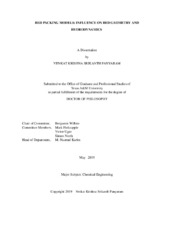| dc.description.abstract | Fixed Bed Reactors are multi-phase reactors where flow of gas, liquid or both phase reactants occurs over a packed bed of solid catalyst. These systems are common in industry as they are easy to construct, operate and maintain. They provide significant contacting of phases with low pressure drop and exhibit relatively low catalyst attrition rates. The complex flow patterns often lead to flow mal-distribution and liquid channeling which in turn leads to non uniform catalytic activity. A manifestation of such consequences is hot spot formation and catalyst and product degradation, which are key concerns with these reactors. This behavior is primarily dictated by the bed structure which influences the flow distribution and catalytic activity. Bed packing configurations produce contacting surfaces for the fluid phases and also aid in catalytic reactions. The configurations developed while packing the beds play an important role in the operation of reactor as they effect the hydrodynamics of the operation by altering the fluid flow behavior. Also, extremely dense beds are known to produce high pressure drops because of the highly tortuous paths. This leads to under utilization of catalyst beds, mal-distribution issues and eventually compromises the safety and product quality. In this study, the bed characteristics of two highly relevant catalyst shapes, spheres and cylinders, are studied. Spherical particle structures comprised of mono-disperse and poly-disperse particle samples and cylinder particle structures comprised of mono-disperse particle samples with two different aspect ratios are generated using the Discrete Element Method (DEM). The beds are prepared using three different loading strategies: Uniform, Sock and Wall, wherein the radial entry position of the particles is varied. Geometric properties of these beds were studied and their potential influence on the flow phenomena is evaluated. Lastly, the spherical particle structures were analyzed using Computational Fluid Dynamics to study the interstitial flow behavior among the spherical particle beds. | en |


